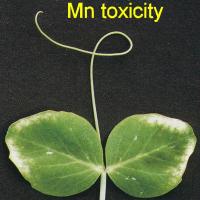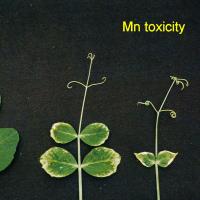Diagnosing manganese toxicity in field peas
Manganese toxicity has not been diagnosed in field peas in Western Australia. It has recently been diagnosed in canola on an acidic heavy soil with high manganese levels. Field peas are more tolerant than canola or cereals.
What to look for
- Symptoms are worse on more acidic heavy textured parts of the paddock.
Paddock
- New leaves and tendrils are first and most severely affected.
- New leaves are pale and rapidly develop light coloured necrotic areas on leaf margins near the apex, that move in toward the midrib between the veins.
- This necrosis can appear as fine pinpoint spots on tendril leaves.
- As the toxicity increases some leaves develop severely necrotic tips and margins that shrivel, leaving the leaf cupped.
Plant
Where did it come from?

Soil type
- With the exception of sands most soils contain manganese, but high levels are more common in fine textured, soils and loamy gravels.
- Soil manganese exists as an oxidised insoluble form and reduced to a water soluble form (Mn++). Activity of oxidising and reducing bacteria that control the ratio between these forms, varies with soil moisture, temperature,texture, and pH.
- With high soil temperature and (even short term) waterlogging, reducing bacteria produce Mn++.
- When waterlogging abates, oxidising bacteria convert Mn++ to insoluble forms , but this ceases when the soil dries and the bacteria can't access Mn++ containing water in fine soil pores.
- Acidic soil has higher levels of Mn++.
- Manganese toxicity is most likely to occur in canola sown into warm acidic heavy soil after soaking rain, folllowed by dry conditions.
- Toxicity will abate as the soil temperature declines in winter.
Management strategies

Lime application
- Plants usually continue to grow despite toxicity symptoms. There is no in-crop treatment.
- Liming is the most economical method to ameliorate manganese toxicity.
- Heavy soils need higher rates per unit of soil to produce the same pH increase as sandy soils
How can it be monitored?

Tissue test

Soil test
- Whole-top plant test provides a guide if paired good/ poor samples are taken.
- Manganese soil tests can only indicate potential for toxicity, as Mn++ levels can vary rapidly according to soil conditions.
- 0-10cm soil pH below 4.5, also increases the risk, and indicates that the soil requires liming to reduce losses from reduced phosphorus availability and possible aluminium toxicity.
See also
Further information
Where to go for expert help
Page last updated: Wednesday, 13 May 2015 - 3:36pm



